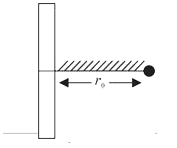A positive point charge is released from rest at a distance r0 from a position line chare with uniform density. The speed v of the point charge as a function of instantaneous distance r from line charge is proportional distance r from line charge is proportional to –
Correct option 4Explanation:
Related Solutions
A positive point charge is released from rest at a distance from a positive line charge with uniform density. The speed (v) of the point charge, as a function of instantaneous distance r from line charge, is proportional to:

View SolutionA positive point charge is connected to a positive line charge of uniform charge density. r_(0) is released from rest at a distance of . The speed (v) of the point charge as a function of the instantaneous distance r from the line charge is proportional to
View SolutionA positive charge is released from rest at a distance from a positive line charge with uniform density . The speed (v) of the point charge , as a function of instantaneous distance r from line charge, is proportional to:

View Solutionविरामावस्था से एक बिन्दु धन आवेश को एक एकसमान घनत्व के धनात्मक रेखीय आवेश से दूरी पर छोड़ते हैं। बिन्दु आवेश की चाल (v), रेखीय आवेश से तात्क्षणिक दूरी r के फलन के रूप में समानुपाती होगी

View SolutionA positive point charge is released from rest at a distance from a positive line charge with uniform density. The speed (v) of the point charge, as a function of instantaneous distance r from line charge, is proportional to:

View SolutionA charge particle is released at a distance from the infinite long wire of linear charge density . Then velocity will be proportional to (At distance from the wire)
_2019_CBT2_E01_009_Q01.png)
View SolutionA charge particle is released at a distance from the infinite long wire of linear charge density . Then velocity will be proportional to (At distance from the wire)

View Solutionकिसी बिन्दु आवेश से दूरी r पर विद्युत् क्षेत्र अनुक्रमानुपाती होता है:
View SolutionHow is the potential at a distance 'r' from a point charge related to the distance 'V'?
View Solutionr is the distance between two point charges of mass m and charge q, they are released from this position. What will be the velocity of each charge when the distance between the two point charges is 2r?
View SolutionThe volume charge density of a sphere carrying charge Q and of radius R is proportional to the square of the distance from the centre. The ratio of the magnitude of the electric field at a distance 2R from the centre to that at a distance of (R )/(2) from the centre is
View SolutionThe electric field at distance .r. from infinte line of charge is
View SolutionThe work done in bringing a unit positive charge from infinite distance to a point at distance x from a positive charge Q is W. Then the potential phi at that point is
View SolutionThe work done in bringing a unit positive charge from infinite distance to a point at distance x from a positive charge Q is W. Then the potential phi at that point is
View SolutionElectric field at a point of distance r from a uniformly charged wire of infinite length having linear charge density lambda is directly proportional to
View SolutionElectric field at a point of distance r from a uniformly charged wire of infinite length having linear charge density lambda is directly proportional to
View SolutionIntensity of electric field at a point at a perpendicular distance .r. from an infinite line charge, having linear charge density is given by :
View SolutionConsider the former model of an atom to be a positively charged point nucleus of charge Ze which is surrounded by a uniform density of negative charge up to radius R. The whole atom is neutral. The electric field at a distance r from the nucleus is
View SolutionA negative charge of 30 esu is at a distance of 30 cm from a positive charge of 20 esu. What is the potential at a point 10 cm from the first charge on the line joining the two charges? Where will the potential be zero?
View Solution